Change of Global Ocean Temperature and Decadal Variability under 1.5 °C Warming in FOAM
Abstract
:1. Introduction
2. Data and Method
2.1. The Fast Ocean Atmosphere Model
2.2. Climate Sensitivity Experiments
2.3. Global Warming Experiments
2.4. Decadal Variability
3. Climate Sensitivity
4. Global Ocean Temperature
5. Decadal Variability
6. Discussions and Conclusions
Author Contributions
Funding
Data Availability Statement
Acknowledgments
Conflicts of Interest
References
- Goodwin, P.; Katavouta, A.; Roussenov, V.M.; Foster, G.L.; Rohling, E.J.; Williams, R.G. Pathways to 1.5 °C and 2 °C warming based on observational and geological constraints. Nat. Geosci. 2018, 11, 102–107. [Google Scholar] [CrossRef]
- Nkemelang, T.; New, M.; Zaroug, M. Temperature and precipitation extremes under current, 1.5 °C and 2.0 °C global warming above pre-industrial levels over Botswana, and implications for climate change vulnerability. Environ. Res. Lett. 2018, 13, 065016. [Google Scholar] [CrossRef]
- Rogelj, J.; Popp, A.; Calvin, K.V.; Luderer, G.; Emmerling, J.; Gernaat, D.; Fujimori, S.; Strefler, J.; Hasegawa, T.; Marangoni, G. Scenarios towards limiting global mean temperature increase below 1.5 °C. Nat. Clim. Change 2018, 8, 325. [Google Scholar] [CrossRef]
- Sanderson, B.M.; Xu, Y.; Tebaldi, C.; Wehner, M.; O’Neill, B.C.; Jahn, A.; Pendergrass, A.G.; Lehner, F.; Strand, W.G.; Lin, L. Community climate simulations to assess avoided impacts in 1.5 and 2 °C futures. Earth Syst. Dyn. 2017, 8, 827–847. [Google Scholar] [CrossRef]
- Jevrejeva, S.; Jackson, L.; Grinsted, A.; Lincke, D.; Marzeion, B. Flood damage costs under the sea level rise with warming of 1.5 °C and 2 °C. Environ. Res. Lett. 2018, 13, 074014. [Google Scholar] [CrossRef]
- Qu, Y.; Liu, Y.; Jevrejeva, S.; Jackson, L.P. Future sea level rise along the coast of China and adjacent region under 1.5° C and 2.0° C global warming. Adv. Clim. Change Res. 2020, 11, 227–238. [Google Scholar] [CrossRef]
- Sanderson, B.M.; O’Neill, B.C.; Tebaldi, C. What would it take to achieve the Paris temperature targets? Geophys. Res. Lett. 2016, 43, 7133–7142. [Google Scholar] [CrossRef]
- Palter, J.B.; Frölicher, T.; Paynter, D.; John, J.G. Climate, ocean circulation, and sea level changes under stabilization and overshoot pathways to 1.5 K warming. Earth Syst. Dyn. 2018, 9, 817–828. [Google Scholar] [CrossRef]
- Lin, L.; Wang, Z.; Xu, Y.; Zhang, X.; Zhang, H.; Dong, W. Additional intensification of seasonal heat and flooding extreme over China in a 2 °C warmer world compared to 1.5 °C. Earth’s Future 2018, 6, 968–978. [Google Scholar] [CrossRef]
- Chen, L.; Qu, X.; Huang, G.; Gong, Y. Projections of East Asian summer monsoon under 1.5 °C and 2 °C warming goals. Theor. Appl. Climatol. 2019, 137, 2187–2201. [Google Scholar] [CrossRef]
- Baker, H.S.; Millar, R.J.; Karoly, D.J.; Beyerle, U.; Guillod, B.P.; Mitchell, D.; Shiogama, H.; Sparrow, S.; Woollings, T.; Allen, M.R. Higher CO2 concentrations increase extreme event risk in a 1.5 °C world. Nat. Clim. Change 2018, 8, 604–608. [Google Scholar] [CrossRef]
- Mitchell, D.; AchutaRao, K.; Allen, M.; Bethke, I.; Beyerle, U.; Ciavarella, A.; Forster, P.M.; Fuglestvedt, J.; Gillett, N.; Haustein, K. Half a degree additional warming, prognosis and projected impacts (HAPPI): Background and experimental design. Geosci. Model Dev. 2017, 10, 571–583. [Google Scholar] [CrossRef]
- Back, L.; Russ, K.; Liu, Z.; Inoue, K.; Zhang, J.; Otto-Bliesner, B. Global hydrological cycle response to rapid and slow global warming. J. Clim. 2013, 26, 8781–8786. [Google Scholar] [CrossRef]
- Abraham, J.P.; Baringer, M.; Bindoff, N.; Boyer, T.; Cheng, L.; Church, J.; Conroy, J.; Domingues, C.; Fasullo, J.; Gilson, J. A review of global ocean temperature observations: Implications for ocean heat content estimates and climate change. Rev. Geophys. 2013, 51, 450–483. [Google Scholar] [CrossRef]
- Chen, X.; Tung, K.-K. Varying planetary heat sink led to global-warming slowdown and acceleration. Science 2014, 345, 897–903. [Google Scholar] [CrossRef]
- Lee, S.-K.; Park, W.; Baringer, M.O.; Gordon, A.L.; Huber, B.; Liu, Y. Pacific origin of the abrupt increase in Indian Ocean heat content during the warming hiatus. Nat. Geosci. 2015, 8, 445–449. [Google Scholar] [CrossRef]
- Farneti, R. Modelling interdecadal climate variability and the role of the ocean. Wiley Interdiscip. Rev. Clim. Change 2017, 8, e441. [Google Scholar] [CrossRef]
- Chen, X.; Tung, K.-K. Global surface warming enhanced by weak Atlantic overturning circulation. Nature 2018, 559, 387–391. [Google Scholar] [CrossRef]
- Fang, C.; Wu, L.; Zhang, X. The impact of global warming on the pacific decadal oscillation and the possible mechanism. Adv. Atmos. Sci. 2013, 31, 118–130. [Google Scholar] [CrossRef]
- Cheng, J.; Liu, Z.; Zhang, S.; Liu, W.; Dong, L.; Liu, P.; Li, H. Reduced interdecadal variability of Atlantic Meridional Overturning Circulation under global warming. Proc. Natl. Acad. Sci. USA 2016, 113, 3175–3178. [Google Scholar] [CrossRef] [Green Version]
- Wu, S.; Liu, Z.-Y. Decadal variability in the North Pacific and North Atlantic under global warming: The weakening response and its mechanism. J. Clim. 2020, 33, 9181–9193. [Google Scholar] [CrossRef]
- Liu, Z.; Kutzbach, J.; Wu, L. Modeling climate shift of El Nino variability in the Holocene. Geophys. Res. Lett. 2000, 27, 2265–2268. [Google Scholar] [CrossRef]
- Wu, L.; Liu, Z.; Gallimore, R.; Jacob, R.; Lee, D.; Zhong, Y. Pacific decadal variability: The tropical Pacific mode and the North Pacific mode. J. Clim. 2003, 16, 1101–1120. [Google Scholar] [CrossRef]
- Liu, Z.; Liu, Y.; Wu, L.; Jacob, R. Seasonal and long-term atmospheric responses to reemerging North Pacific Ocean variability: A combined dynamical and statistical assessment. J. Clim. 2007, 20, 955–980. [Google Scholar] [CrossRef]
- Meraner, K.; Mauritsen, T.; Voigt, A. Robust increase in equilibrium climate sensitivity under global warming. Geophys. Res. Lett. 2013, 40, 5944–5948. [Google Scholar] [CrossRef]
- Knutti, R.; Rugenstein, M.A.; Hegerl, G.C. Beyond equilibrium climate sensitivity. Nat. Geosci. 2017, 10, 727–736. [Google Scholar] [CrossRef]
- Andrews, T.; Gregory, J.M.; Webb, M.J.; Taylor, K.E. Forcing, feedbacks and climate sensitivity in CMIP5 coupled atmosphere-ocean climate models. Geophys. Res. Lett. 2012, 39. [Google Scholar] [CrossRef]
- Cao, J.; Wang, B.; Young-Min, Y.; Ma, L.; Li, J.; Sun, B.; Bao, Y.; He, J.; Zhou, X.; Wu, L. The NUIST Earth System Model (NESM) version 3: Description and preliminary evaluation. Geosci. Model Dev. 2018, 11, 2975–2993. [Google Scholar] [CrossRef]
- Stocker, T.F.; Qin, D.; Plattner, G.-K.; Tignor, M.; Allen, S.K.; Boschung, J.; Nauels, A.; Xia, Y.; Bex, V.; Midgley, P.M. Climate Change 2013: The Physical Science Basis; Cambridge University Press: Cambridge, UK, 2013. [Google Scholar]
- Zhang, Y.; Wallace, J.M.; Battisti, D.S. ENSO-like interdecadal variability: 1900–93. J. Clim. 1997, 10, 1004–1020. [Google Scholar] [CrossRef]
- Mantua, N.J.; Hare, S.R.; Zhang, Y.; Wallace, J.M.; Francis, R.C. A Pacific interdecadal climate oscillation with impacts on salmon production. Bull. Am. Meteorol. Soc. 1997, 78, 1069–1080. [Google Scholar] [CrossRef]
- Enfield, D.B.; Mestas-Nuñez, A.M.; Trimble, P.J. The Atlantic Multidecadal Oscillation and its relation to rainfall and river flows in the continental U.S. Geophys. Res. Lett. 2001, 28, 2077–2080. [Google Scholar] [CrossRef]
- Wu, Z.; Huang, N.E. Ensemble empirical mode decomposition: A noise-assisted data analysis method. Adv. Adapt. Data Anal. 2009, 1, 1–41. [Google Scholar] [CrossRef]
- Gregory, J.M. Vertical heat transports in the ocean and their effect on time-dependent climate change. Clim. Dyn. 2000, 16, 501–515. [Google Scholar] [CrossRef]
- He, C.; Liu, Z.; Hu, A. The transient response of atmospheric and oceanic heat transports to anthropogenic warming. Nat. Clim. Change 2019, 9, 222–226. [Google Scholar] [CrossRef]
- Sutton, R.T.; Hodson, D.L. Atlantic Ocean forcing of North American and European summer climate. Science 2005, 309, 115–118. [Google Scholar] [CrossRef]
- Wu, S.; Liu, Z.-Y.; Cheng, J.; Li, C. Response of North Pacific and North Atlantic decadal variability to weak global warming. Adv. Clim. Change Res. 2018, 9, 95–101. [Google Scholar] [CrossRef]
- Zhang, L.; Delworth, T.L. Simulated response of the Pacific decadal oscillation to climate change. J. Clim. 2016, 29, 5999–6018. [Google Scholar] [CrossRef]
- Li, D.; Zhou, T.; Zou, L.; Zhang, W.; Zhang, L. Extreme high-temperature events over East Asia in 1.5 °C and 2 °C warmer futures: Analysis of NCAR CESM low-warming experiments. Geophys. Res. Lett. 2018, 45, 1541–1550. [Google Scholar] [CrossRef]
- Polyakov, I.V.; Alekseev, G.V.; Bekryaev, R.V.; Bhatt, U.; Colony, R.L.; Johnson, M.A.; Karklin, V.P.; Makshtas, A.P.; Walsh, D.; Yulin, A.V. Observationally based assessment of polar amplification of global warming. Geophys. Res. Lett. 2002, 29, 25-1–25-4. [Google Scholar] [CrossRef]
- Holland, M.M.; Bitz, C.M. Polar amplification of climate change in coupled models. Clim. Dyn. 2003, 21, 221–232. [Google Scholar] [CrossRef]
- MacMartin, D.G.; Zanna, L.; Tziperman, E. Suppression of Atlantic meridional overturning circulation variability at increased CO2. J. Clim. 2016, 29, 4155–4164. [Google Scholar] [CrossRef]
- Armstrong, E.; Valdes, P.; House, J.; Singarayer, J. Investigating the Impact of CO2 on Low-Frequency Variability of the AMOC in HadCM3. J. Clim. 2017, 30, 7863–7883. [Google Scholar] [CrossRef]
- Wang, J.; Li, C. Low-Frequency Variability and Possible Changes in the North Pacific Simulated by CMIP5 Models. J. Meteorol. Soc. Jpn. Ser. II 2017, 95, 199–211. [Google Scholar] [CrossRef]
- Li, S.; Wu, L.; Yang, Y.; Geng, T.; Cai, W.; Gan, B.; Chen, Z.; Jing, Z.; Wang, G.; Ma, X. The Pacific Decadal Oscillation less predictable under greenhouse warming. Nat. Clim. Change 2020, 10, 30–34. [Google Scholar] [CrossRef]
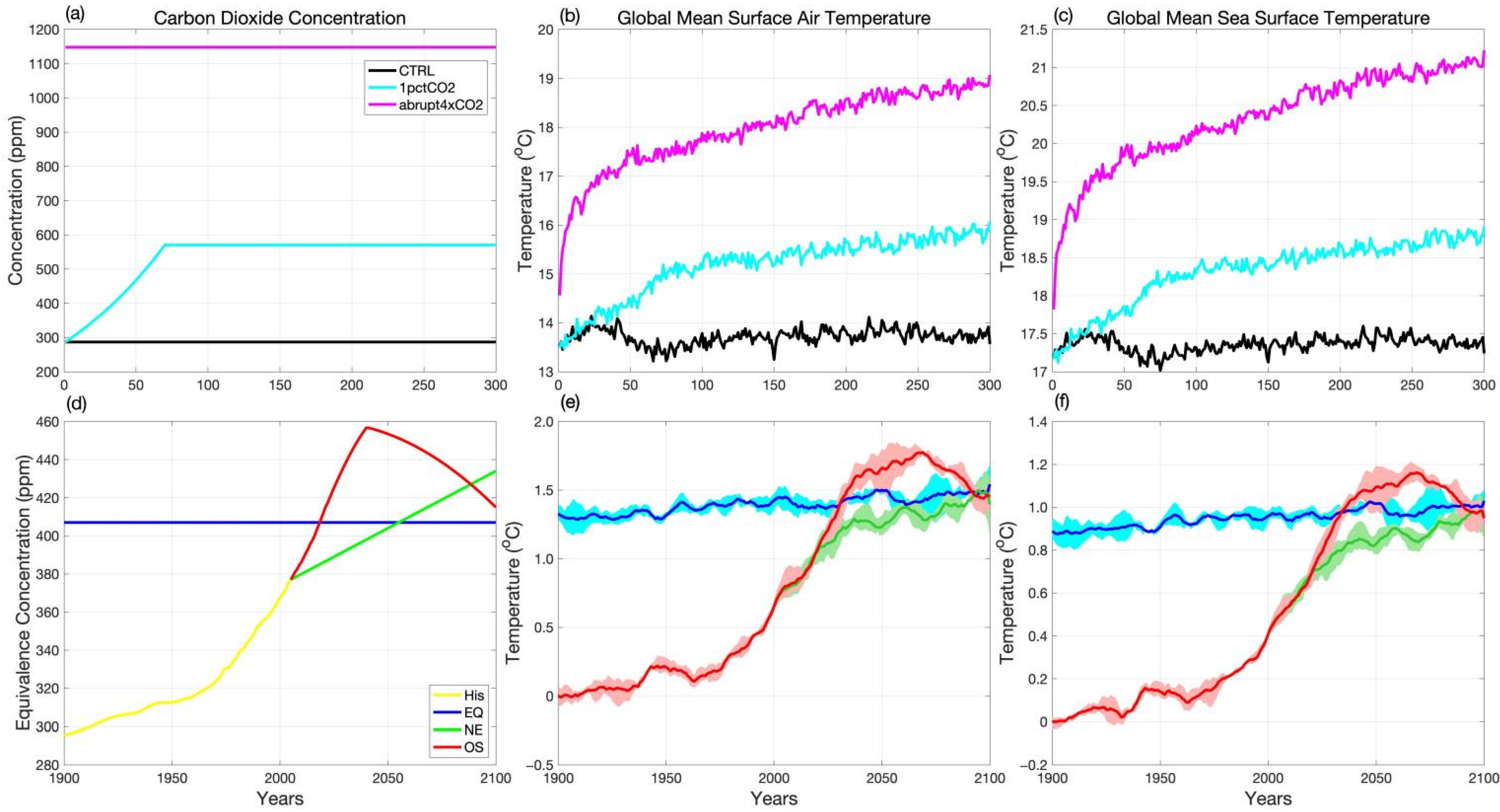
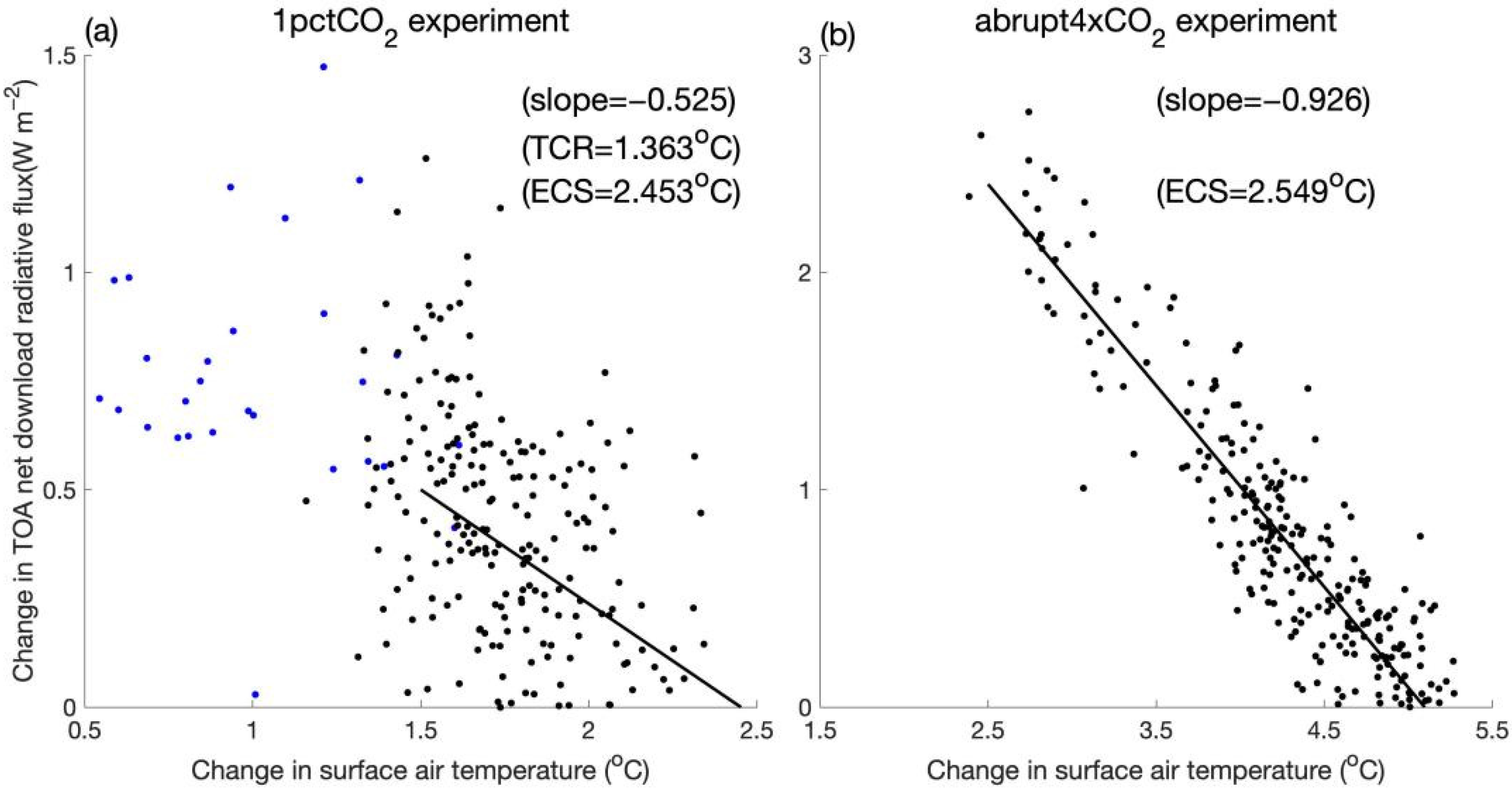

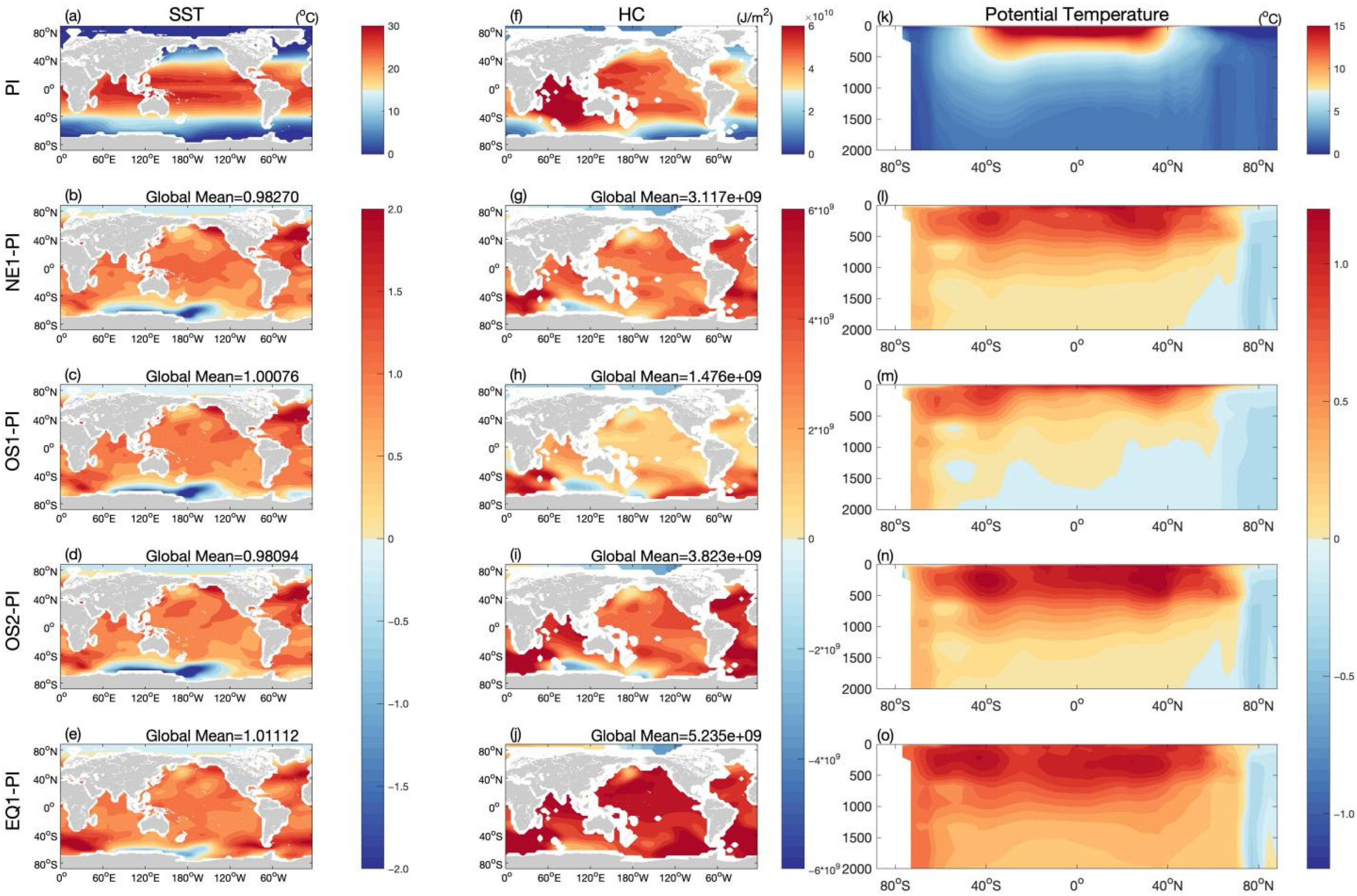
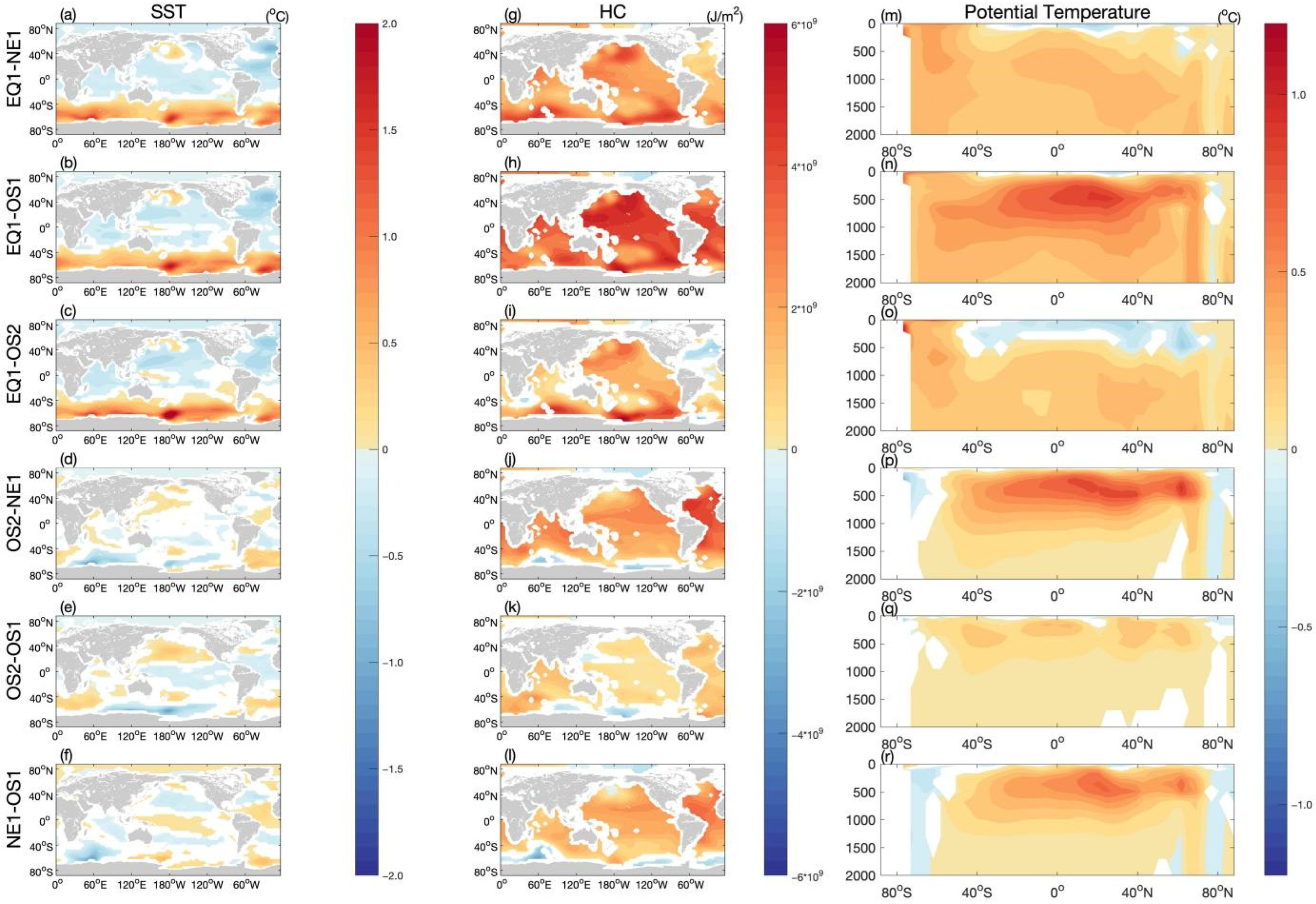
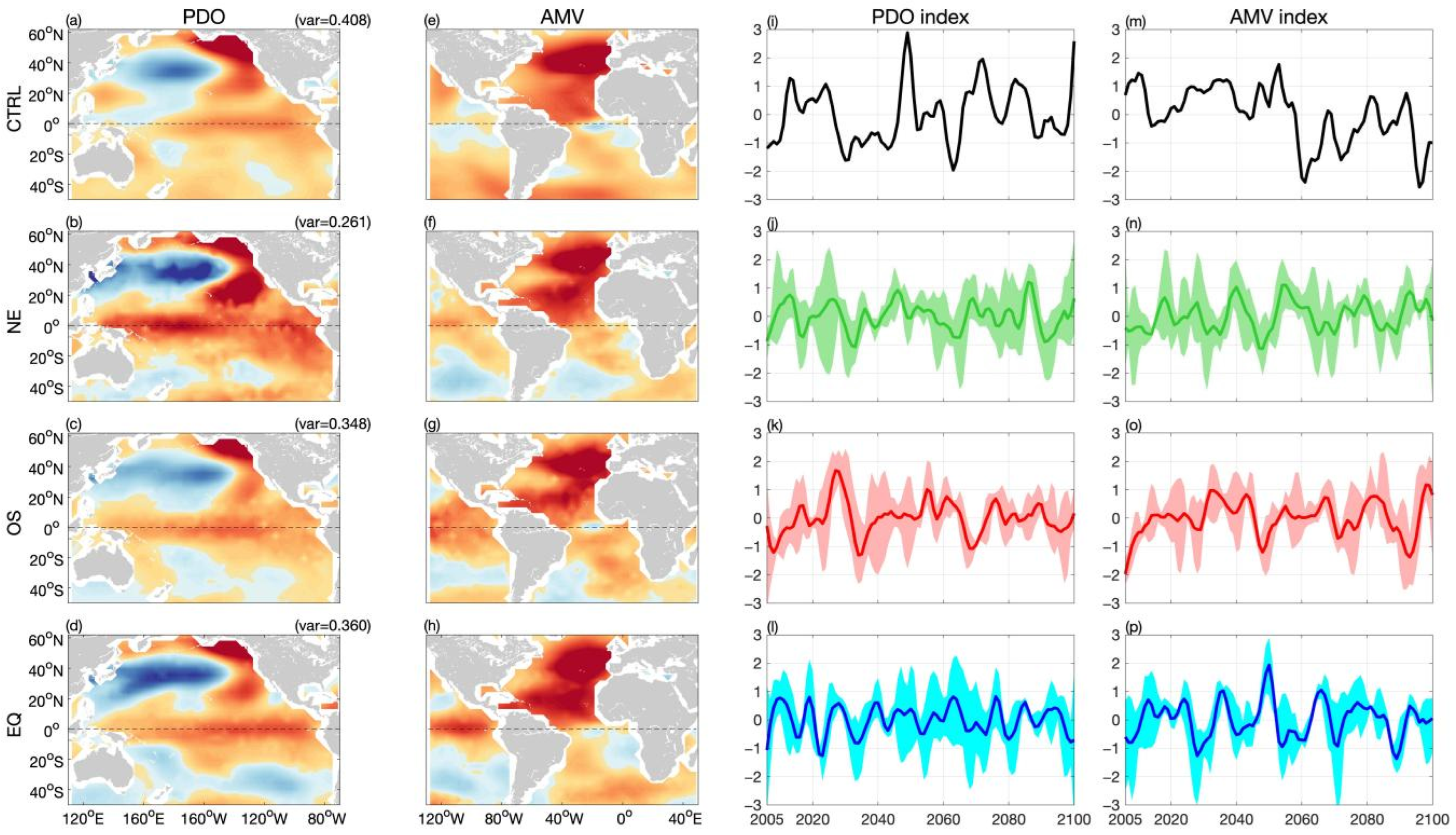
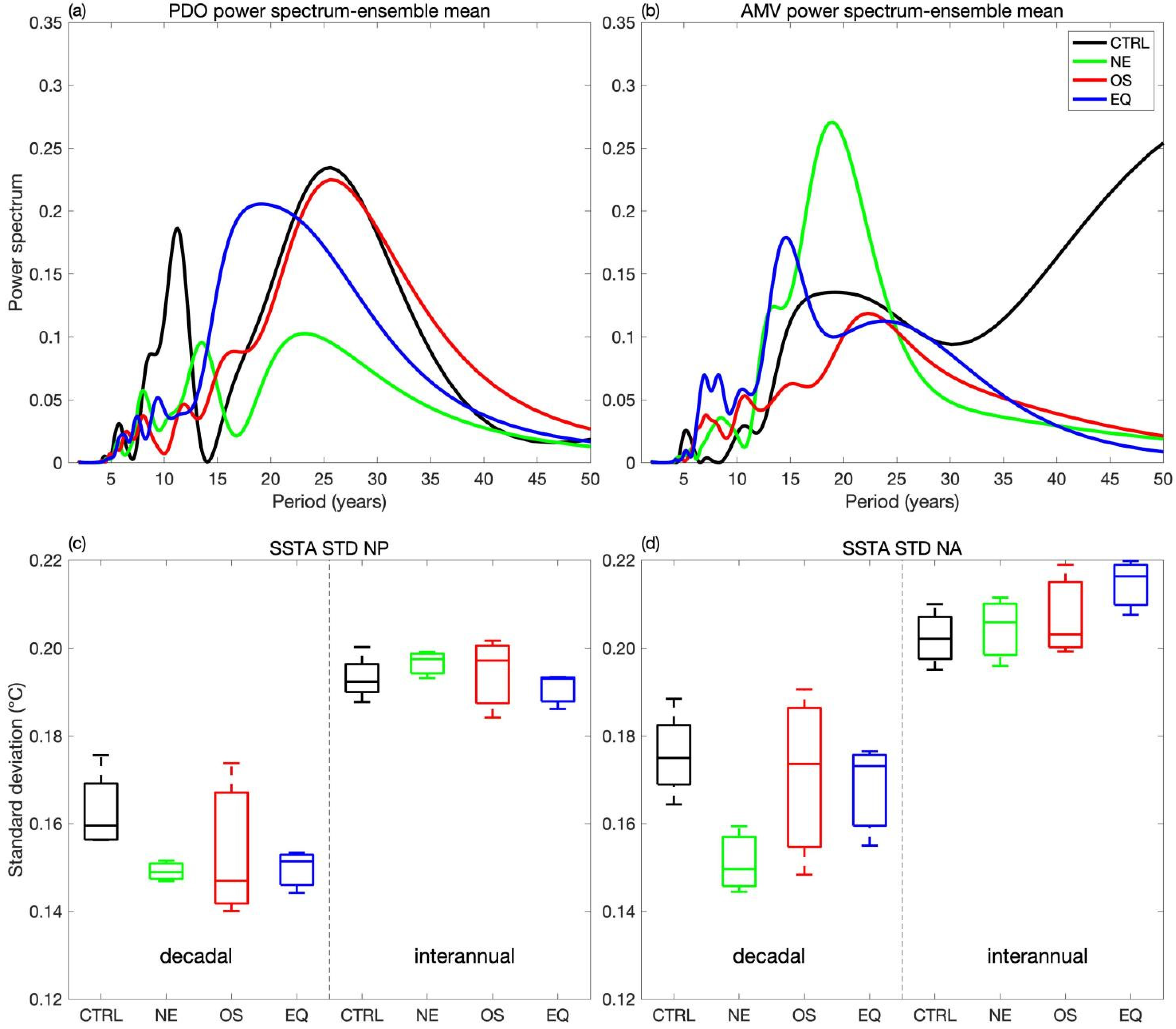

Publisher’s Note: MDPI stays neutral with regard to jurisdictional claims in published maps and institutional affiliations. |
© 2022 by the authors. Licensee MDPI, Basel, Switzerland. This article is an open access article distributed under the terms and conditions of the Creative Commons Attribution (CC BY) license (https://creativecommons.org/licenses/by/4.0/).
Share and Cite
Wu, S.; Liu, Z.; Du, J.; Liu, Y. Change of Global Ocean Temperature and Decadal Variability under 1.5 °C Warming in FOAM. J. Mar. Sci. Eng. 2022, 10, 1231. https://doi.org/10.3390/jmse10091231
Wu S, Liu Z, Du J, Liu Y. Change of Global Ocean Temperature and Decadal Variability under 1.5 °C Warming in FOAM. Journal of Marine Science and Engineering. 2022; 10(9):1231. https://doi.org/10.3390/jmse10091231
Chicago/Turabian StyleWu, Sheng, Zhengyu Liu, Jinbo Du, and Yonggang Liu. 2022. "Change of Global Ocean Temperature and Decadal Variability under 1.5 °C Warming in FOAM" Journal of Marine Science and Engineering 10, no. 9: 1231. https://doi.org/10.3390/jmse10091231



